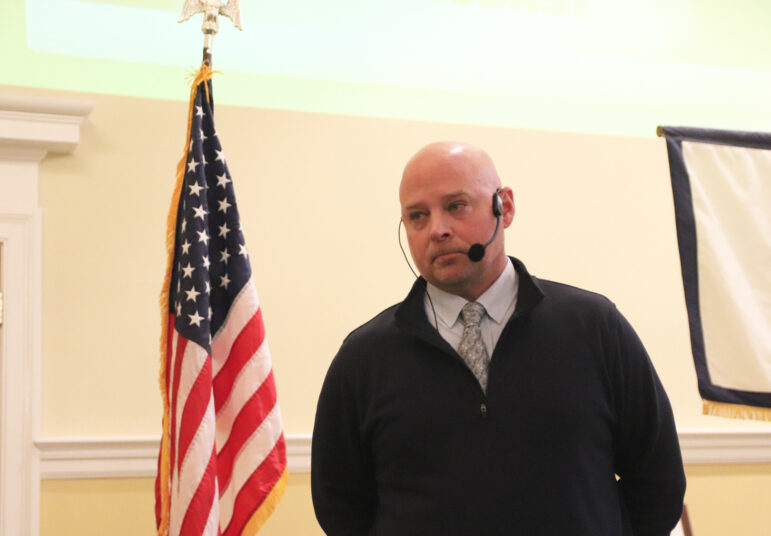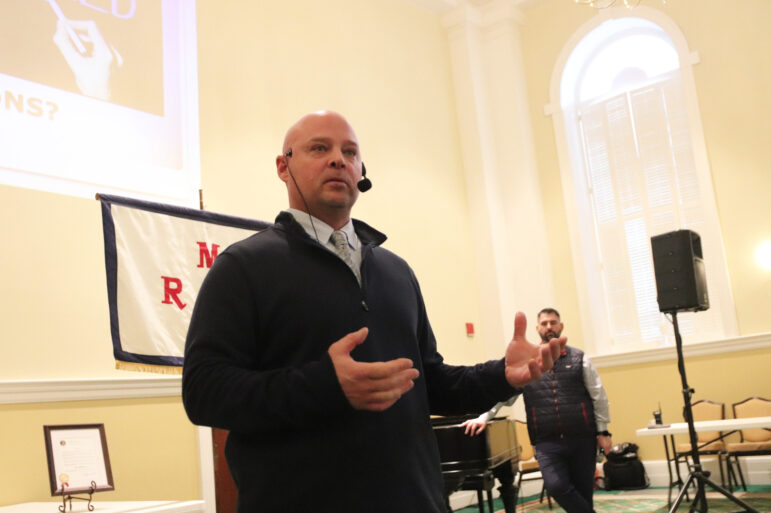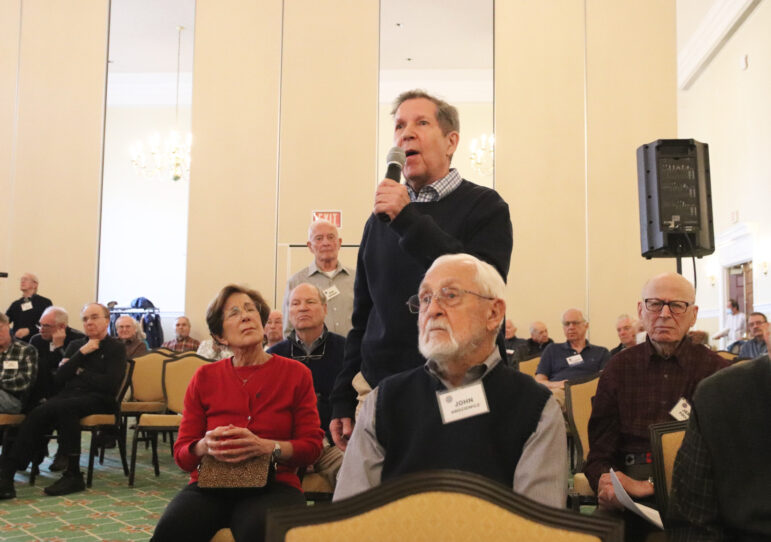Greenwich Police addressed the Greenwich Retired men’s Association on Wednesday to give advice for civilian response in an active shooter situation.
“We all know it’s very hard every night to tune in to the national news and not hear about an active shooter,” said David Michonski of the RMA, who introduced Officers Keith Hirsch and Daniel Paladino, both assigned to the Community Impact Section in the Detective Division. “In the last month we’ve had on average 1.5 active shooting situations in the US every single day.”

Officer Hirsch first talked about situational awareness: being aware of your environment, knowing the exits and having an escape route planned.
“We have become complacent in life,” he said. “Where do you buy your coffee or gas every day? Chances are you don’t even look up. You throw the dollar, you grab the paper, you grab the coffee. Meanwhile maybe the store clerk is being awfully quiet because someone is under the counter holding him at gunpoint.”
Hirsch said too often people are focused on their cell phones rather than their surroundings.
As for mass shootings, which Hirsch defined as three or more victims, Hirsch said there is a perception that they take place daily. He said a person was more likely to be struck by lightning than be a victim of a mass shooting.

On Aug 1, 1966 a single gun man climbed an observation deck at University of Texas at Austin and acted as a sniper, killing 17 people and injuring more.
“Why do we remember this?” he asked. “It was broadcast live.”
Hirsh said the media “gave a very bad person the idea how to get 15 minutes of fame.”
“Does the media play a role? It most certainly has,” he said, giving the example of Adam Lanza’s name being well known.
During Q&A Hirsch was asked whether having more civilians armed with guns made active shooter situations safer.
“I’m not going to comment on what each state is deciding. I think there are 34 states with constitutional carry,” he said. “I’m going to stay away from the politics of it.”
Constitutional Carry means allowing residents and non-residents, age 21+ to carry handguns, long guns, and other weapons including knives, openly or concealed, in public, without a permit.
Connecticut is a May-Issue state, which means an applicant has to pass basic requirements, and the issuing authority uses their own discretion to grant or deny a permit.
Asked whether citizens should have access to automatic weapons, Hirsch demurred. “It’s a political issue.”
Asked why there is more gun violence in the US than in Europe, for example, Officer Hirsch talked about mental health reform.
“When you do the studies after the fact, when you see a high percentage of these shooters had some type of mental illness, I think early detection, getting them the proper help, will help immensely,” he said.
Also, he explained, “You’re seeing schools as well as government facilities change their security structure. As far as central access points and having police officers on scene, you’re seeing a good trend with school shootings on a downward slide.”
A question was raised about automatic weapons and whether society was safer with citizens carrying them.
Again, Hirsch demurred. “Our department when we’re fully staffed, everyone is still going to have a personal opinion.”

Preparing for an Active Shooter Situation: Run, Hide or Fight
RUN
Hirsch said in an active shooter situation, the first recommendation is to run, if possible.
“If you can get out, get out,” he said. “Evacuate regardless if others follow you.”
Hirsch said individuals should prioritize their own safety.
“Leave your belongings behind, get out of the line of fire, try to prevent others from walking into the danger zone, and call 911,” Hirsch said. “Do not attempt to move the wounded.”
Hide
If it’s not possible to run, the second best option is to hide: Lock doors, turn out lights, be quiet and calm, silence your phone.
If you can’t find a safe room or closet, try to conceal yourself behind large objects.
Do not enter corridors without checking them.
“Close and lock all doors. Start throwing tables and chairs up against doors,” Hirsch said. “Whatever we have to do to impede that person’s movement, to slow them down. Turn off all electronic devices.”
“Take cover under a desk, in corners behind obstructions,” he said.
“You’re only going to respond to a uniformed police officer who actually enters the room,” he added, noting that a shooter might pretend to be law enforcement and instruct potential victims to open the door.
He said in an active shooter situation, consider that the fire alarm does not exist.
“In the Parkland, Florida the shooter pulled the fire alarm to try to get kids in the hallway,” Hirsch said. “We’re not listening to the fire alarm system unless we see fire and smell smoke.”
“If possible, dial 911. But if you can’t talk because you think making noise will endanger your location, leave the phone open. Our dispatchers are trained to listen. Call 911 and leave it open.”
Fight
And if neither running nor hiding are possible, the advice is to fight: Act with aggression. Improvise weapons and commit to taking the shooter down.
As a last resort, Hirsch said, “Attempt to incapacitate the threat. What you have in your hands is action, which is always faster than reaction. You have the advantage.”
“Be vocal. Be loud. We know that that stresses people out,” he continued. “That helps.”
Hirsch shared photos of office workers using items available to fight the shooter: throwing chairs, office supplies or even using the fire extinguisher.
When Officers Arrive
Hirsch said when first responders arrive, they are not there to help people evacuate or assist people, but rather to shop the shooter. They are trained to go toward the shooter, while everyone else evacuates, ideally with their hands up and fingers spread out.
“We’re going to be telling you to keep moving. We’re not stopping to help injured people when we first arrive,” he said. “Follow police instructions.”
Hirsch said police might have a variety of uniforms on when they respond.
“We could have gas masks on, we could have helmets,” Hirsch said. We could be in plainclothes, be in jeans, or be from multiple different departments. We might have shotguns, rifles, handguns, you name it.”
“When something like that happens, we’re going to have all the assistance we need from departments around our area. In Newtown I think there was something like 15 different departments.”
Afterward, don’t leave the scene.
“You’re evidence. You may have seen something no one else saw,” he said. “If the shooter got away somehow, you may say, ‘It’s Greg. He worked here 30 years.'”
Be prepared to describe the shooter, their weapon and the number of victims.